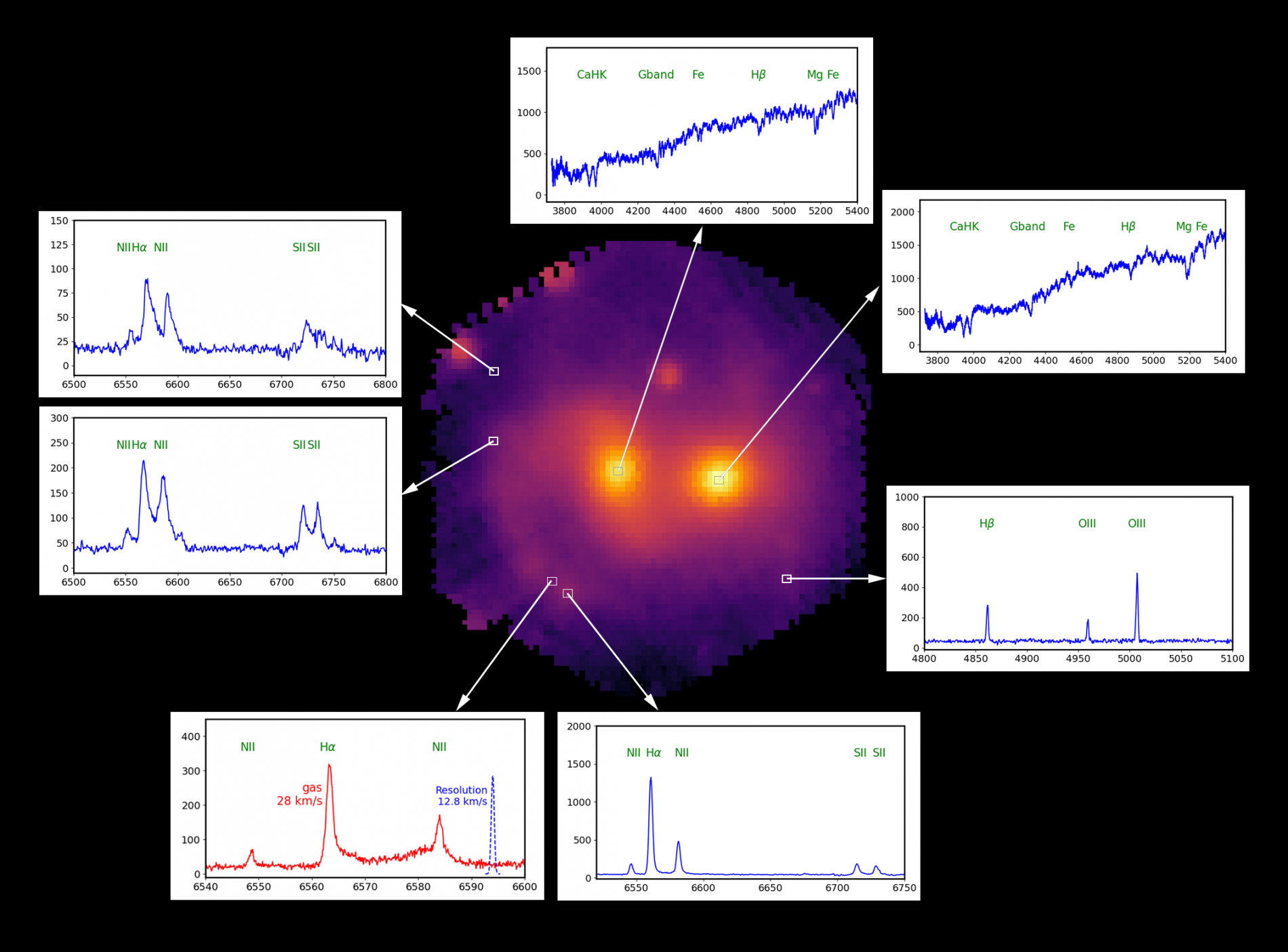WEAVE first light
The Institute of Astrophysics of Andalusia (IAA-CSIC) participates in the WEAVE scientific team, whose first observations already show the high quality of the data that the spectrograph will provide
WEAVE, a powerful state-of-the-art multifibre spectrograph installed on the William Herschel Telescope (WHT) at the Roque de los Muchachos Observatory (La Palma, Canary Islands), has obtained its first light. The instrument, whose scientific team includes the Institute of Astrophysics of Andalusia (IAA-CSIC), has obtained spectra of two of the galaxies in Stephan's Quintet, showing that WEAVE is already generating high-quality data.
The first observations were carried out with the so-called large integral field unit (LIFU) fibre bundle, one of WEAVE's three fibre systems in which 547 closely packed optical fibres transmit light in a hexagonal area of the sky to the spectrograph, where it is analysed and recorded.
The LIFU was aimed at NGC 7318a and NGC 7318b, two galaxies at the heart of Stephan's Quintet, a group of interacting galaxies. The group, 280 million light-years from Earth in the constellation Pegasus, is undergoing a major galaxy collision and provides a natural laboratory for the consequences of galaxy collisions on galaxy evolution. The spectra obtained by WEAVE reveal the motions of stars and gas, the chemical composition of the stars, the temperatures and densities of the gas clouds, among others, and provide insight into how galaxy collisions transform the galaxies in the group.
"Our goal was to host a unique instrument that would enable cutting-edge astronomical research. We are now pleased to demonstrate that the LIFU part of WEAVE not only works, but also produces high-quality data", says Marc Balcells, director of the Isaac Newton Group of Telescopes (ING) to which the telescope hosting WEAVE belongs. For his part, WEAVE principal investigator Gavin Dalton highlights "the wealth of complexity revealed by a single detailed observation of this pair of nearby galaxies, which provides an excellent illustration of the power and flexibility of WEAVE".

WEAVE, A STATE-OF-THE-ART SPECTROGRAPH
WEAVE is a multi-mode, multi-fibre spectrograph built by a consortium of European astronomical institutions, led by the UK's Science and Technology Facilities Council, to become the next generation spectroscopic facility for the WHT.
WEAVE uses optical fibres to collect light from celestial sources and transmits it to a two-armed spectrograph. The spectrograph separates the light into its different wavelengths, or colours, and records them on large-format CCD light detectors. WEAVE's versatility is one of its greatest strengths. While the LIFU mode houses 547 tightly packed fibres to image large areas of the sky, in MOS mode up to 960 individual fibres can be placed separately using two robots to capture the light from many hundreds of stars, galaxies or quasars. In mIFU mode, the fibres are organised into 20 units, each consisting of 37 fibres, which are used to study small and large targets, such as nebulae and distant galaxies.
WEAVE also provides velocities along the line of sight through the Doppler effect. Depending on the science target, there is a choice between two spectral resolution powers: at low resolution, the spectra distinguish velocity differences of about 5 kilometres per second, and at high resolution of 1.2 kilometres per second. Even at its lowest power of resolution, WEAVE records the line-of-sight velocities of stars with accuracies similar to those of the transverse velocities measured by ESA's Gaia satellite.

SCIENCE WITH WEAVE
Over the next five years, the ING will devote 70% of the time available at the WHT to eight large surveys with WEAVE, selected from those proposed by the astronomical communities of the partner countries. All of these surveys require spectra of up to millions of individual stars and galaxies, a goal made possible by WEAVE's ability to observe nearly a thousand objects at a time.
These surveys cover studies of stellar evolution, Milky Way science, galaxy evolution and cosmology. In synergy with the European Space Agency's Gaia satellite, WEAVE's MOS mode will be used to obtain spectra of several million stars in the disc and halo of our host galaxy, enabling the development of Milky Way archaeology. Nearby and distant galaxies, some detected by the LOFAR radiotelescope, will be studied for their growth history. And quasars will be used as beacons to map the spatial distribution and interaction of gas and galaxies when the universe was only about 20% of its present age.
The ING will also make 30% of the time available for projects competitively selected from among those proposed by astronomers in ING partner countries. These projects will take advantage of WEAVE's versatility to provide quick answers to immediate questions. There are also channels for programmes that jointly exploit WEAVE and the diverse capabilities of the telescopes of the Canary Islands Observatories such as the 10.4 metre Gran Telescopio Canarias.
WEAVE's construction has been funded by the Science and Technology Facilities Council (STFC, UK), the Netherlands Research School for Astronomy (NOVA, NL), the Dutch Science Foundation (NWO, NL), the Isaac Newton Group of Telescope (ING, UK/NL/ES), the Astrophysical Institute of the Canaries (IAC, ES), the Ministry of Economy and Competitiveness (MINECO, ES), the Ministry of Science and Innovation (MCI), the European Regional Development Fund (ERDF), the National Institute for Astrophysics (INAF, IT), the French National Centre for Scientific Research (CNRS, FR), Paris Observatory – University of Paris Science and Letters (FR), Besançon Observatory (FR), Region île de France (FR), Region Franche-Comté (FR), Instituto Nacional de Astrofísica, Óptica y Electrónica (INAOE, MX), National Council for Science and Technology (CONACYT, MX), Lund Observatory (SE), Uppsala University (SE), the Leibniz Institute AIP (DE), Max-Planck Institute for Astronomy (MPIA, DE), University of Pennsylvania (US), and Konkoly Observatory (HU).
Shoko Jin et al., 2022, "The wide-field, multiplexed, spectroscopic facility WEAVE: Survey design, overview, and simulated implementation", MNRAS, accepted for publication. http://arxiv.org/abs/2212.03981
Instituto de Astrofísica de Andalucía (IAA-CSIC)
Unidad de Divulgación y Comunicación
Silbia López de Lacalle - sll[arroba]iaa.es - 958230676
https://www.iaa.csic.es
https://divulgacion.iaa.csic.es

